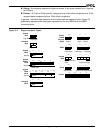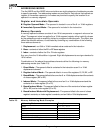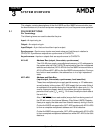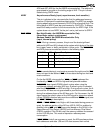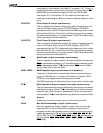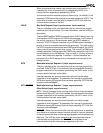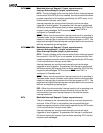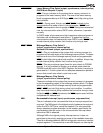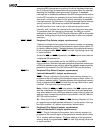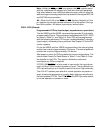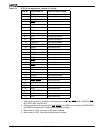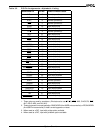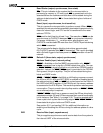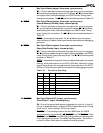
System Overview
3-7
LCS/ONCE0 Lower Memory Chip Select (output, synchronous, internal pullup)
ONCE Mode Request 0 (input)
LCS
—This pin indicates to the system that a memory access is in
progress to the lower memory block. The size of the lower memory
block is programmable up to 512 Kbyte. LCS
is held High during a bus
hold condition.
ONCE
0—During reset, this pin and UCS/ONCE1 indicate to the
microcontroller the mode in which it should operate. ONCE
0 and
ONCE
1 are sampled on the rising edge of RES. If both pins are asserted
Low, the microcontroller enters ONCE mode; otherwise, it operates
normally.
In ONCE mode, all pins assume a high-impedance state and remain in
that state until a subsequent reset occurs. To guarantee that the
microcontroller does not inadvertently enter ONCE mode, ONCE
0 has
a weak internal pullup resistor that is active only during a reset.
MCS
3/RFSH Midrange Memory Chip Select 3
(output, synchronous, internal pullup)
Automatic Refresh (output, synchronous)
MCS
3—This pin indicates to the system that a memory access is in
progress to the fourth region of the midrange memory block. The base
address and size of the midrange memory block are programmable.
MCS
3 is held High during a bus hold condition. In addition, this pin has
a weak internal pullup resistor that is active during reset.
RFSH
—This pin provides a signal timed for auto refresh to PSRAM
devices. It is only enabled to function as a refresh pulse when the
PSRAM mode bit is set in the LMCS Register. An active Low pulse is
generated for 1.5 clock cycles with an adequate deassertion period to
ensure that overall auto refresh cycle time is met.
MCS
2–MCS0 Midrange Memory Chip Selects
(output, synchronous, internal pullup)
These pins indicate to the system that a memory access is in progress
to the corresponding region of the midrange memory block. The base
address and size of the midrange memory block are programmable.
MCS
2–MCS0 are held High during a bus hold condition. In addition,
they have weak internal pullup resistors that are active during a reset.
Unlike the UCS
and LCS chip selects, the MCS outputs assert with the
multiplexed AD address bus.
NMI Nonmaskable Interrupt (input, synchronous, edge-sensitive)
This pin indicates to the microcontroller that an interrupt request has
occurred. The NMI signal is the highest priority hardware interrupt and,
unlike the INT4–INT0 pins, cannot be masked. The microcontroller
always transfers program execution to the location specified by the
nonmaskable interrupt vector in the microcontroller interrupt vector
table when NMI is asserted.
Although NMI is the highest priority interrupt source, it does not
participate in the priority resolution process of the maskable interrupts.
There is no bit associated with NMI in the interrupt in-service or interrupt
request registers. This means that a new NMI request can interrupt an



